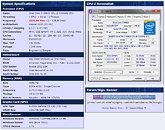Thursday, January 29th 2015

Kingston HyperX Sets DDR4 Overclocking World Record at 4351MHz
HyperX, a division of Kingston Technology, the independent world leader in memory products, today announced its HyperX Predator DDR4 memory was overclocked at 4351 MHz, the highest frequency among all DDR4 memory in the world. The mark was set by overclocker "Toppc" of MSI using one 4GB HyperX Predator 3333MHz DDR4 module on the new MSI X99S XPOWER AC motherboard. The valid CPU-Z screenshot can be found here. The video of the overclocking record can be found here.
In addition to having the highest frequency, 10 out of the top 20 memory clock records were achieved using HyperX Predator DDR4 memory. Eight of those records were set at the recent HyperX OC Takeover (HOT) World Finals event during 2015 International CES, where the world's top overclocker's gathered to compete for $15,000 (USD) in prize money. HyperX DDR4 memory currently also has the top scores in two other benchmarks recognized by HWBOT, MaxxMEM and MaxxMEM Read Bandwidth, respectively.HyperX Predator DDR4 3333MHz 16GB Kit of 4 memory is the fastest Intel XMP-certified memory kit. The Extreme Memory Profile (XMP) allows users to overclock memory beyond standard specifications. To gain XMP certification, memory modules must pass a rigorous test procedure that ensures stability and reliability.
HyperX is the high-performance product division of Kingston Technology encompassing high-speed DDR4 and DDR3 memory, SSDs, USB Flash drives and gaming accessories. Targeted at gamers, overclocker's and enthusiasts, HyperX is known throughout the world for quality, performance and innovation. HyperX is committed to eSports as it sponsors over 20 teams globally and is the main sponsor of Intel Extreme Masters. HyperX can be found at many shows including Brasil Game Show, China Joy, DreamHack, gamescom and PAX.
In addition to having the highest frequency, 10 out of the top 20 memory clock records were achieved using HyperX Predator DDR4 memory. Eight of those records were set at the recent HyperX OC Takeover (HOT) World Finals event during 2015 International CES, where the world's top overclocker's gathered to compete for $15,000 (USD) in prize money. HyperX DDR4 memory currently also has the top scores in two other benchmarks recognized by HWBOT, MaxxMEM and MaxxMEM Read Bandwidth, respectively.HyperX Predator DDR4 3333MHz 16GB Kit of 4 memory is the fastest Intel XMP-certified memory kit. The Extreme Memory Profile (XMP) allows users to overclock memory beyond standard specifications. To gain XMP certification, memory modules must pass a rigorous test procedure that ensures stability and reliability.
HyperX is the high-performance product division of Kingston Technology encompassing high-speed DDR4 and DDR3 memory, SSDs, USB Flash drives and gaming accessories. Targeted at gamers, overclocker's and enthusiasts, HyperX is known throughout the world for quality, performance and innovation. HyperX is committed to eSports as it sponsors over 20 teams globally and is the main sponsor of Intel Extreme Masters. HyperX can be found at many shows including Brasil Game Show, China Joy, DreamHack, gamescom and PAX.

12 Comments on Kingston HyperX Sets DDR4 Overclocking World Record at 4351MHz
I don't think people appreciate having their opinions decided and spoken for them.
All you need to do is run real programs to prove it to yourself. The theoretical performance in benches looks great but it assumes the DRAM is always saturated, which it is not. That's why real world performance shows insignificant system gains.
Oh wait too late :D